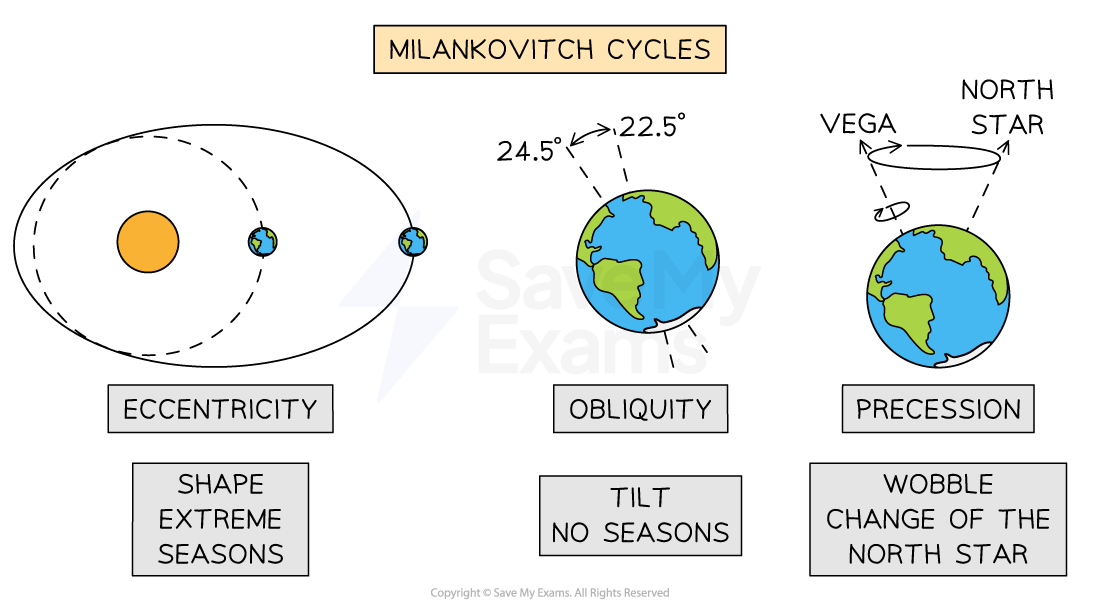Syllabus Edition
First teaching 2024
First exams 2026
Milankovitch Cycles (HL) (DP IB Environmental Systems & Societies (ESS)): Revision Note
Milankovitch cycles
Milankovitch cycles describe three long-term changes in Earth's position and movement relative to the Sun
These cycles impact the amount of solar radiation Earth receives
This influences the climate over very long timescales (tens to hundreds of thousands of years)
The cycles contribute to natural climate patterns such as:
Ice ages
Warmer interglacial periods
Three types of Milankovitch cycles
1. Eccentricity (shape of Earth’s orbit)
Eccentricity refers to the shape of Earth's orbit around the Sun
This orbit changes from a more circular shape to a more elliptical shape over a cycle of about 100,000 years
When the orbit is more elliptical, Earth’s distance from the Sun varies more
This creates larger differences in solar radiation received at different times of the year
When the orbit is more circular, the distance from the Sun remains more constant
This leads to smaller differences in seasonal temperatures
Climate impact:
Lower eccentricity (circular orbit) results in milder seasonal differences
This milder climate can allow ice sheets to slowly build up over time, especially in polar regions
If the Earth’s tilt is also smaller, the poles receive less direct sunlight, making it harder for ice to melt
As a result, snow and ice accumulate
This can lead to the onset of a glacial period or ice age
2. Obliquity (tilt of Earth's axis)
Axial tilt refers to the angle at which Earth's axis tilts in relation to its orbit around the Sun
The tilt angle changes from about 22.5° to 24.5° over a cycle of approximately 41,000 years
Greater tilt increases the intensity of seasons, making summers warmer and winters colder
Climate impact:
A higher tilt (closer to 24.5°) creates stronger seasonal contrasts
This can reduce the buildup of polar ice by making summers warmer
A lower tilt (closer to 22.1°) reduces seasonal contrasts
This allows ice to persist at the poles and contributes to glaciation
3. Precession (wobble of Earth's axis)
Axial precession is the wobble in Earth's rotational axis
This cycle takes approximately 26,000 years and causes the timing of seasons to shift
As Earth wobbles, the position of the North Star gradually changes
Climate impact:
Precession affects the seasonal distribution of solar radiation
This can lead to warmer or cooler summers and winters
This depends on where Earth is in its orbit when each season occurs

Milankovitch cycles and climate change
The combined effects of eccentricity, obliquity, and precession drive long-term climate shifts, like the Ice Ages
Positive feedback loops amplify these climate shifts
For example, cooling from reduced solar radiation can lead to glaciation
This snow and ice reflect sunlight (albedo effect) and cause further cooling
Warming increases carbon dioxide, enhancing the greenhouse effect and leading to interglacial periods
Role of carbon dioxide:
Lower temperatures reduce carbon dioxide in the atmosphere, enhancing cooling
Cooler temperatures make the atmosphere less able to hold gases like carbon dioxide, which the oceans or soils then absorb
Higher temperatures release more carbon dioxide, enhancing warming
This occurs because warmer temperatures increase the rate at which carbon dioxide is released from sources like soils, oceans, and plant life
This increases atmospheric carbon dioxide levels
Real-world examples
Last glacial maximum:
It occurred approximately 20,000 years ago when eccentricity, axial tilt, and precession aligned to favour cooling
Resulted in extensive ice sheets covering parts of North America and Europe
Current interglacial period:
We are currently in a warmer interglacial period called the Holocene, which began around 11,700 years ago
This period has allowed the development of human civilisation due to the relatively stable and warmer climate
Examiner Tips and Tricks
Although Milankovitch cycles explain natural long-term climate patterns, they do not explain recent, rapid global warming, which is mainly due to human activities like fossil fuel burning.

Unlock more, it's free!
Did this page help you?